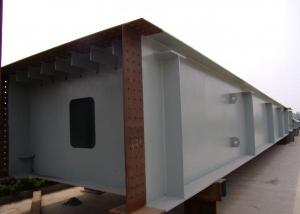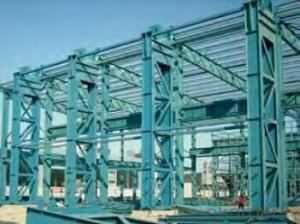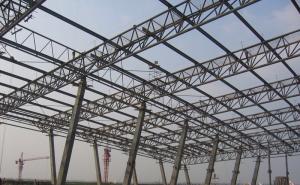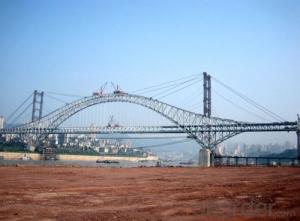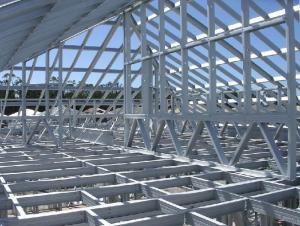Viaduct Bridge Steel Structure
- Loading Port:
- Tianjin Port
- Payment Terms:
- TT or LC
- Min Order Qty:
- 1000MTONS m.t.
- Supply Capability:
- 5000MTONS/MONTH m.t./month
OKorder Service Pledge
OKorder Financial Service
You Might Also Like
Specifications of viaduct bridge steel structure
Project type: main street viaduct steel structure
The steel dosage: 2760MTs
Building area: 1116M2
The unit component weight: 25.6MTs
Bridge wide: 24M
The long span: 30-35m
Viaduct is from the West Second Ring Road to East Second Ring Road, a total length of 11.55 kilometers, the bridge 24 meters wide, two-way six-lane
1. GB standard material
2. High Structural safety and reliability
3. The production can reach GB/JIS/ISO/ASME standard
Packaging & Delivery of viaduct bridge steel structure
1. According to the project design and the component size, usually the main component parts are nude packing and shipped by bulk vessel. And the small parts are packed in box or suitable packages and shipped by containers.
2. This will be communicated and negotiated with buyer according to the design.
Engineering Design Software of viaduct bridge steel structure
Tekla Structure \ AUTO CAD \ PKPM software etc
⊙Complex spatial structure project detailed design
⊙Construct 3D-model and structure analysis. ensure the accuracy of the workshop drawings
⊙Steel structure detail ,project management, automatic Shop Drawing, BOM table automatic generation system.
⊙Control the whole structure design process, we can obtain higher efficiency and better results
Technical support of viaduct bridge steel structure
|
Worker |
Rate of frontline workers with certificate on duty reaches 100% |
|
Welder |
186 welders got AWS & ASME qualification 124 welders got JIS qualification 56 welders got DNV &BV qualification |
|
Technical inspector |
40 inspectors with UT 2 certificate 10 inspectors with RT 2 certificate 12 inspectors with MT 2 certificate 3 inspectors with UT3 certificate |
|
Engineer |
21 engineers with senior title 49 engineers with medium title 70 engineers with primary title. 61 First-Class Construction Engineers 182 Second-Class Construction Engineers |
|
International certification |
10 engineers with International Welding engineer, 8 engineers with CWI. |
Production Flow of steel structure
Material preparation—cutting—fitting up—welding—component correction—rust removal—paint coating—packing—to storage and transportation (each process has the relevant inspection)
steel structure square column production line steel structure component fitting-up machine
Usage/Applications of steel structure
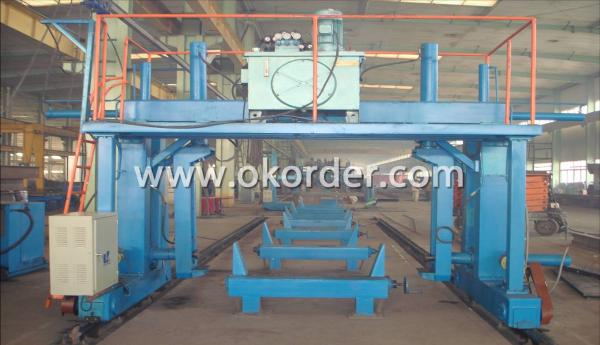
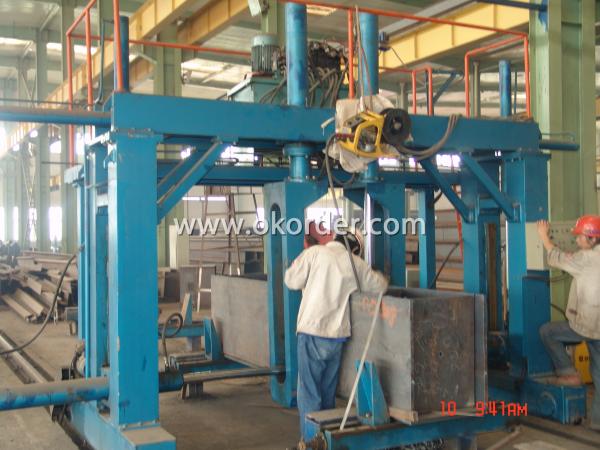
*Characters of Structure Steel
1. Steel is characterized by high strength, light weight, good rigidity, strong deformation capacity, so it is suitable for construction of large-span, super high and super-heavy buildings particularly;
2. It with good homogeneous and isotropic, is an ideal elastomer which perfectly fits the application of general engineering;
3. The material has good ductility and toughness, so it can have large deformation and it can well withstand dynamic loads;
4. Steel structure’s construction period is short;
5. Steel structure has high degree of industrialization and can realize-specialized production with high level of mechanization.
*Steel structure application
1. Heavy industrial plants: relatively large span and column spacing; with a heavy duty crane or large-tonnage cranes; or plants with 2 to 3 layers cranes; as well as some high-temperature workshop should adopt steel crane beams, steel components, steel roof, steel columns, etc. up to the whole structure.
2. Large span structure: the greater the span of the structure, the more significant economic benefits will have by reducing the weight of the structure
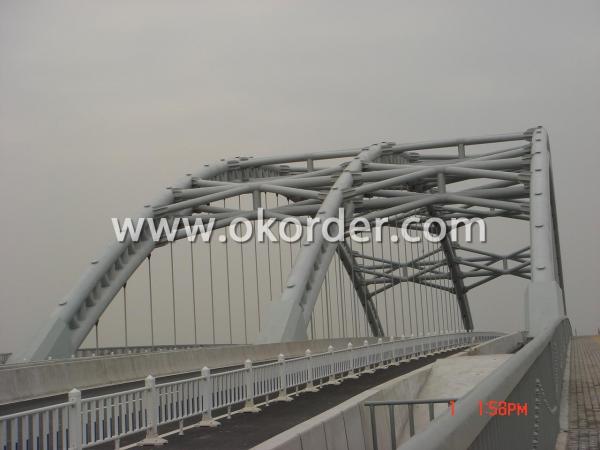
3. Towering structures and high-rise buildings: the towering structure, including high-voltage transmission line towers, substation structure, radio and television emission towers and masts, etc. These structures are mainly exposed to the wind load. Besides of its light weight and easy installation, structure steel can bring upon with more economic returns by reducing the wind load through its high-strength and smaller member section.
4. Structure under dynamic loads: As steel with good dynamic performance and toughness, so it can be used directly to crane beam bearing a greater or larger span bridge crane
5. Removable and mobile structures: Structure Steel can also apply to movable Exhibition hall and prefabricated house etc by virtue of its light weight, bolt connection, easy installation and uninstallation. In case of construction machinery, it is a must to use structure steel so as to reduce the structural weight.
6. Containers and pipes: the high-pressure pipe and pipeline, gas tank and boiler are all made of steel for the sake of its high strength and leakproofness
7. Light steel structure: light steel structures and portal frame structure combined with single angle or thin-walled structural steel with the advantages of light weight, build fast and steel saving etc., in recent years has been widely used.
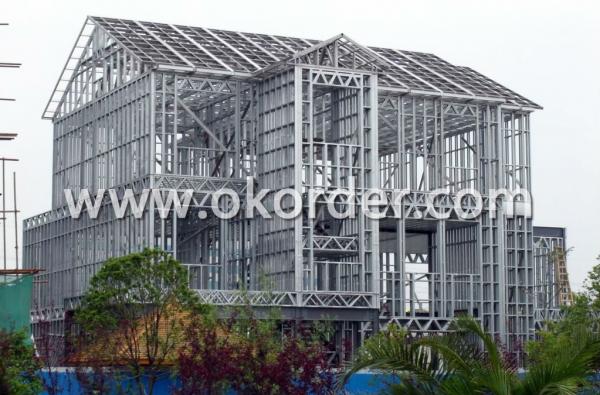
8. Other buildings: Transport Corridor, trestle and various pipeline support frame, as well as blast furnaces and boilers frameworks are usually made of steel structure.
All in all, according to the reality, structure steel is widely used for high, large, heavy and light construction.
- Q: What are the different techniques for fireproofing steel structures?
- There are several techniques for fireproofing steel structures, including the use of intumescent coatings, spray-applied fire resistive materials (SFRMs), and encasement with concrete or gypsum-based boards. Intumescent coatings are paint-like materials that expand and form an insulating char when exposed to heat, protecting the steel from high temperatures. SFRMs are lightweight materials applied as a spray or trowel-on coating, providing thermal insulation and slowing down heat transfer. Encasement involves surrounding the steel members with concrete or gypsum-based boards, creating a barrier that can withstand fire. Each technique has its own advantages and suitability depending on the specific requirements of the steel structure.
- Q: What are the design considerations for steel structures in healthcare and medical facilities?
- Some design considerations for steel structures in healthcare and medical facilities include: 1. Structural Integrity: Steel structures need to be designed to withstand the weight of heavy medical equipment, such as MRI machines, and to ensure the safety and stability of the building during seismic events or extreme weather conditions. 2. Flexibility and Adaptability: Healthcare facilities often undergo renovations or expansions to accommodate changing medical technologies and patient needs. Steel structures offer greater flexibility for future modifications, as they can be easily altered or extended without compromising the strength of the building. 3. Infection Control: Healthcare facilities must maintain high standards of cleanliness and infection control. Steel structures can be designed with smooth, non-porous surfaces that are easy to clean and disinfect, reducing the risk of bacterial growth and contamination. 4. Fire Resistance: Fire safety is crucial in healthcare facilities, where patients may have limited mobility or require special assistance. Steel structures can be designed to meet stringent fire resistance requirements, ensuring the safety of patients, staff, and valuable medical equipment. 5. Noise Reduction: Healthcare facilities require a quiet and calm environment for patient care and recovery. Steel structures can be designed with noise-reducing materials and techniques to minimize noise transmission from mechanical systems, equipment, or outside sources. 6. Energy Efficiency: Healthcare facilities consume significant amounts of energy, and steel structures can contribute to energy efficiency through the use of insulation, efficient HVAC systems, and natural lighting strategies. This can help reduce operational costs and carbon footprint. Overall, design considerations for steel structures in healthcare and medical facilities revolve around ensuring the safety, functionality, cleanliness, and comfort of the building, while also allowing for future adaptability and sustainability.
- Q: What are the common design considerations for steel sports arenas or stadiums?
- Some common design considerations for steel sports arenas or stadiums include structural integrity, seating capacity and arrangement, acoustics, accessibility, lighting, ventilation, and sustainability. The use of steel as a construction material allows for large spans and flexible design options. The structure must be able to withstand various loads, such as the weight of the roof, seating, and equipment, as well as seismic and wind forces. Seating capacity and arrangement need to provide optimal viewing angles for spectators, ensuring a great experience. Acoustics play a vital role in enhancing the sound experience during events, while accessibility ensures that the venue can accommodate people with disabilities. Adequate lighting and ventilation systems are essential for visibility, comfort, and safety. Lastly, incorporating sustainable practices in design, such as utilizing energy-efficient systems and materials, can contribute to reducing the environmental impact of the sports arena or stadium.
- Q: What does a product frame refer to in a steel structure workshop?
- A frame should refer to a section. This section can completely express a plane beam column component, mainly on the map to express the shape of the frame beam column, reinforcement, reinforcement layout and overlap anchorage, and so on.
- Q: What is the role of welding in steel structures?
- The role of welding in steel structures is crucial and indispensable. Welding is the process of joining two or more pieces of metal together, and it is widely used in the construction of steel structures. First and foremost, welding provides structural integrity and strength to steel structures. By fusing the metal pieces together, welding creates a continuous and seamless connection, making the structure more robust and capable of withstanding various external forces such as wind, earthquakes, and heavy loads. This ensures the overall stability and safety of the steel structure. Moreover, welding allows for the fabrication of complex and intricate designs in steel structures. It enables the construction of various shapes and sizes, making it possible to create buildings, bridges, pipelines, and other structures with specific architectural and functional requirements. Welding also facilitates the joining of different steel components, such as beams, columns, and plates, enabling the creation of large and durable structures. Additionally, welding provides cost-effectiveness and efficiency in the construction of steel structures. By using welding techniques, it becomes possible to join different steel elements quickly, reducing the overall construction time. This leads to cost savings in terms of labor and materials. Furthermore, welding allows for the assembly and disassembly of steel structures, making them easier to transport and install on-site. Furthermore, welding ensures the longevity and durability of steel structures. By creating strong and reliable connections, welding helps prevent the formation of weak points or potential failure zones in the structure. This enhances the lifespan of the steel structure, reducing the need for frequent maintenance and repairs. In summary, welding plays a vital role in steel structures by providing structural integrity, enabling complex designs, ensuring cost-effectiveness and efficiency, and enhancing longevity and durability. Without welding, the construction and functionality of steel structures would be significantly compromised.
- Q: How do steel structures provide resistance against blast and impact loads?
- Due to their inherent strength and ductility, steel structures are able to resist blast and impact loads effectively. Steel possesses unique properties, such as high tensile strength and elasticity, which make it an ideal material for enduring extreme forces. When a blast or impact occurs, the steel structure absorbs the energy generated by the explosion or collision. This crucial energy absorption capability prevents the structure from collapsing or experiencing catastrophic damage. Steel is capable of distributing the load over a larger area, thereby reducing the intensity of the impact on any singular point. This property becomes particularly important when dealing with high-pressure waves or shockwaves resulting from explosions. Furthermore, steel exhibits a high resistance to shattering or fragmentation. Consequently, steel structures tend to deform rather than break into smaller pieces, even under intense forces. This deformation ability aids in dissipating energy and minimizing the impact on the structure. Moreover, steel structures can be designed with flexibility and redundancy. Incorporating elements such as bracing, damping systems, or energy-absorbing materials allows the structure to further enhance its resistance to blast and impact loads. These design considerations enable the structure to withstand sudden and dynamic forces generated by blasts or impacts without compromising its overall integrity. Additionally, steel structures can be constructed with blast-resistant materials, including reinforced concrete or steel plates. These materials can be strategically placed in vulnerable areas to create a protective barrier that absorbs and redirects forces. In conclusion, the combination of steel's high strength, ductility, energy absorption capacity, and flexibility in design make it an excellent choice for providing resistance against blast and impact loads. The ability of steel structures to withstand extreme forces ensures the safety and stability of buildings, bridges, and other infrastructure during unexpected events.
- Q: How are steel structures used in the construction of mining facilities?
- Steel structures are commonly used in the construction of mining facilities due to their durability, strength, and versatility. They are used to create the framework for buildings, such as processing plants, warehouses, and offices, as well as support structures like conveyor systems and storage tanks. Steel's high load-bearing capacity and resistance to harsh environmental conditions make it ideal for withstanding the heavy machinery, equipment, and materials used in mining operations. Additionally, steel structures can be easily modified and expanded, allowing for flexibility in adapting to evolving mining needs.
- Q: How does steel perform in terms of corrosion resistance?
- Steel performs well in terms of corrosion resistance due to the presence of elements such as chromium and nickel that form a protective layer on its surface, preventing oxidation and rusting. However, the specific corrosion resistance of steel can vary depending on its composition and environmental conditions.
- Q: Can steel structures be designed to be self-cleaning or low-maintenance?
- Yes, steel structures can be designed to be self-cleaning or low-maintenance. Various strategies can be employed to achieve this. One method is to use a high-quality protective coating on the steel surface, such as a galvanized or powder-coated finish. These coatings provide a barrier against corrosion and dirt accumulation, making it easier to clean the structure. Additionally, the design can incorporate features that promote self-cleaning, such as sloped surfaces or strategic placement of rainwater collection systems to naturally wash away dirt and debris. Furthermore, advancements in nanotechnology have led to the development of self-cleaning coatings that use photocatalytic materials to break down organic matter and prevent dirt from sticking to the surface. Overall, with proper design considerations and the use of appropriate protective coatings, steel structures can be made self-cleaning or low-maintenance, reducing the need for frequent cleaning and maintenance efforts.
- Q: What are the fire safety considerations for steel structures?
- Fire safety considerations for steel structures include the use of fire-resistant coatings or intumescent paints, adequate fire suppression systems such as sprinklers, proper compartmentalization and fire barriers, and regular inspections and maintenance to ensure structural integrity and prevent potential fire hazards.
1. Manufacturer Overview
| Location | SHANDONG,China |
| Year Established | 2008 |
| Annual Output Value | Above US$20 Billion |
| Main Markets | WEST AFRICA,INDIA,JAPAN,AMERICA |
| Company Certifications | ISO9001:2008;ISO14001:2004 |
2. Manufacturer Certificates
| a) Certification Name | |
| Range | |
| Reference | |
| Validity Period |
3. Manufacturer Capability
| a) Trade Capacity | |
| Nearest Port | TIANJIN PORT/ QINGDAO PORT |
| Export Percentage | 0.6 |
| No.of Employees in Trade Department | 3400 People |
| Language Spoken: | English;Chinese |
| b) Factory Information | |
| Factory Size: | Above 150,000 square meters |
| No. of Production Lines | Above 10 |
| Contract Manufacturing | OEM Service Offered;Design Service Offered |
| Product Price Range | Average, High |
Send your message to us
Viaduct Bridge Steel Structure
- Loading Port:
- Tianjin Port
- Payment Terms:
- TT or LC
- Min Order Qty:
- 1000MTONS m.t.
- Supply Capability:
- 5000MTONS/MONTH m.t./month
OKorder Service Pledge
OKorder Financial Service
Similar products
Hot products
Hot Searches
Related keywords

